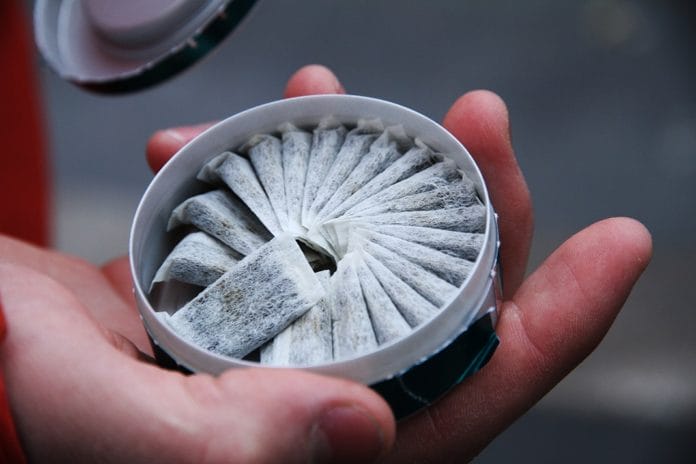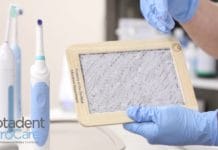The Oral Cancer Foundation states the average age of a first-time smokeless tobacco user is just 10 years old. As seen with the recent trends in vaping, tobacco companies consistently use flavoring and fun packaging to entice younger customers to buy products that are ultimately addictive and damaging to their health.
Smokeless tobacco users absorb two to three times the amount of addictive nicotine that smokers do. Eight to 10 dips per day are equivalent to smoking 30 to 40 cigarettes.6
What is Smokeless Tobacco?
Chewing tobacco, snuff, dip, snus, and dissolvable tobaccos are all forms of smokeless tobacco (SLT). Chew, also known as “spit” tobacco, is sold as loose leaf, plugs or twists of tobacco, and is sometimes flavored. Snuff is a finely ground tobacco packed dry, moist, or in sachets, which are small packs of the ground tobacco, also known as snus. Snus has become increasingly popular because little to no spitting is involved as with other SLT products. Dissolvable options come as lozenges, sticks, strips similar to breath-freshening strips, or orbs that resemble Tic Tacs candy.5,6
All forms of tobacco are causative agents in oral cancer. Tobacco is derived from Nicotiana tabacum and Nicotiana rustica. Nicotine is a volatile alkaloid that affects all organs but works by binding to a central nervous system receptor. The resulting increase in dopamine is what makes nicotine addictive.4,6
Smokeless tobacco is usually placed between the cheek and gum. Some users sniff or inhale dry snuff, but that practice is more common in Europe than in the United States. The nicotine in SLTs stays in the bloodstream longer than that from cigarettes, cigars, or pipe smoking.6
Smokeless tobaccos contain over 2,000 chemicals and at least 28 carcinogens. Some of these carcinogens include formaldehyde, acetaldehyde, hydrazine, arsenic, cadmium, benzopyrene, lead, and radioactive polonium from the soil tobacco leaves grow in. The most concerning ingredients in smokeless tobacco are tobacco-specific nitrosamines (TSNAs) that are formed during the curing, fermenting, and the aging process.6 TSNAs are potent carcinogens which are directly linked to cancer risk.1
Previous to 1996, tobacco companies were not required to report specific amounts of certain chemicals, including TSNAs, to the FDA. That changed when the Family Smoking Prevention and Tobacco Control Act passed. This gave the FDA the authority to regulate the manufacturing, distribution, and marketing of tobacco products. Tobacco companies are now required to add warnings to their labels, indicating the risks of oral cancer, gum disease, and tooth loss.
Most importantly, federal law allows the FDA to restrict marketing and sales to youth.5 Despite actions to bring awareness about the dangers of smokeless tobacco, moist snuff between the years 2000-2014, in particular, saw a 77% rise in popularity and now leads smokeless tobacco sales.1,2
Who Uses Smokeless Tobacco?
Dental hygienists should gather information on tobacco use during the health history review of patients of all ages. In the U.S. in 2016, a reported 3.4% of adults aged 18-plus used smokeless tobacco. The states with the highest numbers were in Wyoming, West Virginia, Arkansas, and Montana.
In 2017, 5.5% of high school students in the United States reported use, with 1.1% of those students stating the use of multiple tobacco products.5 Although smokeless tobacco use is six times more common in men, one in 100 women use smokeless tobacco regularly, and female youths report using SLTs as a regular means of diet and weight control.5,6
Effects of Smokeless Tobacco in the Oral Cavity
Smokeless tobacco has damaging effects on the teeth and gingiva. SLTs often contain coarse abrasives that, when chewed, cause abrasion and tooth wear. These abrasives are theorized to be added to accelerate nicotine absorption in the tissues, but this is denied by manufacturers.4,6 Stains from smokeless tobacco penetrate the enamel, dentin, root surfaces, and even prosthetic appliances.
Tobacco users experience 67% more tooth loss than non-smokers due to decay. This is attributed to the sweetening and flavor added to many SLT products. Periodontal tissues of SLT users have increased gingival recession leading to exposed root surfaces, periodontal pocket formation, plaque and calculus accumulation, and periodontal disease.4
Oral Cancer from SLT
Oral cancer is one of the most curable cancers with early detection, but it also one of the deadliest if not caught in early stages. The United States diagnoses 49,000 new cases of oral cancer yearly, contributing to the global total of 300,000; 9,750 deaths a year in the U.S. are due to oral cancer.3 Oral cancer treatment usually involves surgery and sometimes radiation or chemotherapy.3
Smokeless tobacco users are at increased risk of cancer of the oral cavity, throat, larynx, and esophagus.6
Common oral cancers attributed to smokeless tobacco are squamous cell carcinoma and verrucous carcinoma. Squamous cell carcinoma can appear clinically as ulcerative lesions with a distinct rolled border.4 The typical placement of SLT between the cheek and gum means that 80% of oral squamous cell carcinomas involve the buccal tissue. The pooling nature of saliva and tobacco fluids may also involve the lateral tongue or floor of the mouth with this cancer.
Verrucous carcinoma is considered slower growing and much “lazier” than squamous cell carcinoma. It grows laterally and can be diffuse and covered by leukoplakic patches. This cancer is more common on the gingiva, buccal tissue, or commissure areas.4
Other oral potentially malignant disorders include keratotic or hyperkeratotic tissue changes, which are sometimes called “tobacco pouch keratosis,” such as erythroplakia and leukoplakia. Both conditions are mostly asymptomatic.
Leukoplakia can present with a red component that may indicate candida colonization, which may increase dysplasia and malignancy concerns. Erythroplakia is usually a red patch with a granular velvet-like surface and will have well-circumscribed clinical margins.4 Among SLT users, 75% have leukoplakia, which is sometimes a precursor to oral cancer. Long-term snuff users have 50% more risk of developing cheek or gum cancer.6
Oral Cancer Screening
Oral cancer screening involves a visual and physical exam of the extraoral and intraoral tissue. Visually check the patient’s face for bilateral symmetry and palpate the tissues of the head and neck looking for any swelling, masses, or nodules that should not be present. Intraoral palpation and visual exam require retraction of the tongue to examine the floor of the mouth, vestibule, posterior tongue, and throat.
The Oral Cancer Foundation has a detailed cancer screening protocol that is a thorough refresher for dental hygienists. There are several professional tools on the market that use dyes, rinses, and lights to highlight any concerning tissue changes that may have not yet presented clinically.3 Screening for oral cancer should be done by a dentist or dental hygienist at every opportunity, not just during preventative care appointments.
The American Association of Oral and Maxillofacial Surgeons provides this helpful and printable oral cancer self-exam guide for patient use at home. Dental professionals should encourage patients who use tobacco and other oral cancer-causing agents to follow these instructions, to be aware of what their normal tissue looks like, and be able to identify anything new or abnormal. Instruct patients to report to your office or an ENT if any new lesion does not resolve within 10 to 14 days on its own.
Smokeless Tobacco Cessation
The Oral Cancer Foundation calls oral cancer “Dentistry’s Cancer.” As dental hygienists, it is our responsibility to find ways to gently remind all tobacco users of their resources for help in quitting at each visit. Nicotine alternatives or replacement products, behavioral therapy, and individual and group therapy are great options to start. For those who may need additional help, there are prescription options they may consult their doctor about such as varenicline tartrate (Chantix) or bupropion (Zyban) that may help some patients to reduce withdraw symptoms.5,6
Dental hygienists should obtain updated state and local resources offered for those ready to quit. Smokefree.gov is recommended by the CDC for those who want to begin a plan to quit. It is a national organization that offers a support line 1-800-QUIT-NOW (1-800-784-8669) and a text option called DipfreeTXT that will send three to five messages of support daily. The National Cancer Institute is another resource for information on quitting smokeless tobacco that offers a helpline at 1-800-44U-QUIT (1-800-448-7848) or an online LiveHelp online chat.
To further promote oral cancer awareness in your community, check The Oral Cancer Foundation for events such as free oral cancer screenings and lectures, or participate in one of their run/walks in your area!
Need CE? Click Here to Check Out the Self-Study CE Courses from Today’s RDH!
Listen to the Today’s RDH Dental Hygiene Podcast Below:
References
- Ahmad, B.T., Basser, H.T., Bokhari, T.H., Janbaz, K.H., Qadir, M.I. Risk for oral cancer from smokeless tobacco. Contemporary Oncology. 2014; 18(3): 160–164. doi: https://dx.doi.org/10.5114/wo.2014.40524.
- Hodge, K., Richter, P., Stanfill, S., Watson, C., Zhang, L. Surveillance of moist snuff: total nicotine, moisture, pH, un-ionized nicotine, and tobacco-specific nitrosamines. Nicotine & Tobacco Research. 2008; 10(11): 1645–1652. Retrieved from http://dx.doi.org/10.1080/14622200802412937.
- Huot, R.A. (n.d.). Cancer From Dip: The Facts About Smokeless Tobacco. Retrieved from https://www.colgate.com/en-us/oral-health/conditions/cancer/cancer-from-dip–the-facts-about-smokeless-tobacco- .
- Muthukrishnan, A., Warnakulasuriya, S. Oral Health consequences of smokeless tobacco use. The Indian Journal of Medical Research. 2018; 148(1): 35–40. doi: https://dx.doi.org/10.4103/ijmr.IJMR_1793_17
- Smokeless Tobacco Use in the United States. (2018, August 29). Retrieved March 24, 2020, from https://www.cdc.gov/tobacco/data_statistics/fact_sheets/smokeless/use_us/index.htm
- Tobacco forms and types. (2018, June 5). Retrieved from https://oralcancerfoundation.org/understanding/tobacco/tobacco-forms-types/












